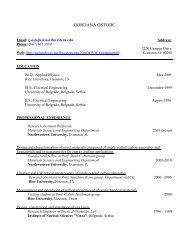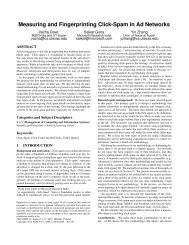The Collateral Damage of Internet Censorship by DNS Injection
The Collateral Damage of Internet Censorship by DNS Injection
The Collateral Damage of Internet Censorship by DNS Injection
You also want an ePaper? Increase the reach of your titles
YUMPU automatically turns print PDFs into web optimized ePapers that Google loves.
<strong>DNS</strong> Level Affected Resolvers Affected RateRoot 1 0.002%TLD 11573 26.40%Authoritative 99 0.23%Table 6: Number <strong>of</strong> affected resolvers in differentlevel.paper will raise awareness <strong>of</strong> the collateral damage caused<strong>by</strong> indiscriminate <strong>DNS</strong> censorship. If ISPs only act to censorcustomers, not transit, this prevents the collateral damage.However, because <strong>of</strong> the closed nature <strong>of</strong> the many censorshipactivities (such as the <strong>DNS</strong> filter in China), it is unclearto us if there are any technical challenges for those ISPs toimplement such policy or not.If the censoring ISPs do not change their current practice<strong>of</strong> <strong>DNS</strong>-injection, another possibility is for neighboring ISPsto consider them invalid for transit: the neighbors shouldprefer alternate paths and not advertise transit wheneveran alternate path exists. In particular, the TLD operatorsshould monitor their peering arrangements to check for censoredpaths.Finally, and most importantly, <strong>DNS</strong>SEC naturally preventsthis collateral damage, especially on the TLD level.Both the .de and .kr domains sign their results, enabling a<strong>DNS</strong>SEC-validating resolver which rejects the unsigned injectedreplies while waiting for the legitimate signed repliesto avoid suffering collateral damage due to packet injection.6. CONCLUSION<strong>The</strong> contributions <strong>of</strong> this paper include:(1) Comprehensive analysis <strong>of</strong> collateral damage<strong>by</strong> <strong>DNS</strong> injection. Iterative queries to different level <strong>of</strong>name servers, multiple name servers distributed in differentlocations and dynamic and anycast routing, are all factorswhich may cause a query to transit a censored network, eventhough both the user and the target are outside the censoredarea.(2) Discovering and locating <strong>DNS</strong> injectors. Weprobed all the <strong>Internet</strong> to find the indiscriminate <strong>DNS</strong> injectors,locating these <strong>DNS</strong> injectors in 39 Chinese ASes.(3) Measurement <strong>of</strong> affected recursive resolvers allover the world. We measured 43,842 open recursive resolversin 173 countries, and found that 26.41% <strong>of</strong> them in109 countries could be polluted.(4) Primary path <strong>of</strong> pollution: from resolver toTLD servers. We find that the primary collateral damagearises from transit between the resolver and the TLDauthorities, particularly the authorities for .de and .kr.We expect to continue our study on the measurement <strong>of</strong>the collateral damage caused <strong>by</strong> <strong>DNS</strong> injection, using multiplevantage points and an expanded list <strong>of</strong> HoneyQueries.Although we has not come to a solution to allow recursiveresolvers to be immune to the collateral damages from <strong>DNS</strong>basedcensorship apart from <strong>DNS</strong>SEC validation, we hopeour result can increase the <strong>Internet</strong> community’s awareness<strong>of</strong> such behaviors, and take actions to actively detect andresist such pollution to the whole <strong>Internet</strong>.2010.http://www.renesys.com/tech/presentations/pdf/<strong>DNS</strong>-Tampering-and-Root-Servers.pdf.[2] R. Bush, M. Patton, R. Elz, and S. Bradner. Selectionand Operation <strong>of</strong> Secondary <strong>DNS</strong> Servers. RFC2182,1997.[3] J. Crandall, D. Zinn, M. Byrd, E. Barr, and R. East.ConceptDoppler: A Weather Tracker for <strong>Internet</strong><strong>Censorship</strong>. In Proceedings <strong>of</strong> the 14th ACMConference on Computer and CommunicationsSecurity, CCS’07, pages 352–365, New York, NY,USA, 2007. ACM.[4] M. Dischinger, M. Marcon, S. Guha, K. P. Gummadi,R. Mahajan, and S. Saroiu. Glasnost: Enabling EndUsers to Detect Traffic Differentiation. In Proceedings<strong>of</strong> the 7th USENIX conference on Networked systemsdesign and implementation, NSDI’10, pages 27–27,Berkeley, CA, USA, 2010. USENIX Association.[5] R. Elz and R. Bush. Clarifications to the <strong>DNS</strong>Specification. RFC2181, 1997.[6] M. V. Ereche. Odd Behaviour on One Node in Iroot-server, 2010.https://lists.dns-oarc.net/pipermail/dnsoperations/2010-March/005260.html.[7] G. Lowe, P. Winters, and M. L. Marcus. <strong>The</strong> Great<strong>DNS</strong> Wall <strong>of</strong> China.http://cs.nyu.edu/~pcw216/work/nds/final.pdf,2007.[8] P. Mockapetris. Domain Names - Concepts andFacilities. RFC1034, 1987.[9] P. Mockapetris. Domain Names - Implementation andSpecification. RFC1035, 1987.[10] C. Partridge, T. Mendez, and W. Milliken. HostAnycasting Service. RFC1546, 1993.[11] L. Spitzner. Honeytokens: <strong>The</strong> Other Honeypot.http://www.symantec.com/connect/articles/honeytokens-other-honeypot, 2003.7. REFERENCES[1] M. A. Brown, D. Madory, A. Popescu, andE. Zmijewski. <strong>DNS</strong> Tampering and Root Servers, Nov.





